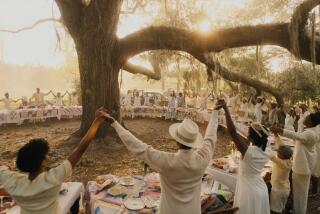Review: ‘Diana Vreeland’ unfolds in grand fashion
Charismatic, imperious and quick-witted, Diana Vreeland ruled in the world of couture and cutting-edge culture for more than 50 years as the editor of Harper’s Bazaar, then Vogue, from which she was unceremoniously fired in 1971. Remarkably, much of that sizzling sensibility was caught on film and has been stylishly stitched together with her personal history in the scrumptious new documentary, “Diana Vreeland: The Eye Has to Travel.”
Her story, as much a portrait of an early-day feminist as that of a fashion maven, traces a career that got its start in the ‘20s and was winding down just as the second wave of the women’s movement was gaining traction, ushered in by Betty Friedan’s “The Feminine Mystique” in 1963.
Under Vreeland’s reign — she was dubbed the “empress of fashion” for a reason — the magazines she edited became a force for inclusion; she used models of all nationalities and sent photographers for fashion shoots to developing countries. She embraced the avant garde and, when it came along, the rock ‘n’ roll ethos and its stars.
As Jackie Onassis once observed, “To say that Diana Vreeland has dealt only with fashion trivializes what she has done. She has commented on the times.”
The editor’s life and legacy come alive in the documentary, directed by a trio that includes Lisa Immordino Vreeland (she married a grandson but never met the matriarch), Bent-Jorgen Perlmutt and Frederic Tcheng. The movie is filled with rare footage, photos and interviews with close friends and relatives that might not have been possible for anyone not in the immediate family.
The captivating center is Vreeland herself, whether reflecting back for George Plimpton, who began collaborating on her memoir when she was in her 80s, or the many conversations with the media that tracked her rise. She has a cocktail-party style of whispered confidences and burnished bravado, an impeccable sense of timing and a theatrical rasp courtesy of years of smoking that make for entertaining listening. The only drawback in a personality that large is that no one else, whatever their insights or artistic pedigree, is quite as interesting.
The film kicks off with a delightfully wry excerpt of Vreeland and Plimpton’s first discussion as the writer urges her to talk about her earliest influences. It takes place in her ornately infamous red living room that screamed of posh style and a fiery and fearless approach to life. The room, which she described as “a garden in hell,” is the perfect setting to introduce the devilish diva.
It doesn’t take much coaxing to get Vreeland talking. She was born in Paris in 1903 during the Belle Époque era of bustles and parasols, the ugly-duckling daughter of parents whose house was a salon for the artists of the age. The family moved to America as World War I was beginning, so Vreeland’s sense of style from the outset was eclectic — the genteel elegance of Belle Époque, the risqué frenzy of the Roaring ‘20s. As a new era would emerge, she would add the essence of that style to her visual repertoire — “the eye has to travel,” she would explain.
Throughout, the filmmakers are quite effective in showing the ways in which the events and influences in her life make their presence felt in the pages of the magazines. We begin to understand what created her distinctive fashion aesthetic as well as her drive.
Case in point is what she did with her mother’s “ugly duck” pronouncement. Rather than cower or cover, Vreeland flaunted the hard lines of her face, sweeping her black hair back so that nothing would hide that profile. Years later she would honor another unconventional profile with a page-filling shot of a young Barbra Streisand. She would marry the most handsome boy in her circle, Reed Vreeland, whom she described in typical Vreelandese as “the most ravishing, devastating killer-diller.”
A chance encounter at a cocktail party not long after they married became a career changer. She’d dabbled in fashion, developing her own strong sophisticated style, but that party landed her a column in Harper’s Bazaar. Called “Why Don’t You?” it was filled with provocative fashion ideas, and soon the eclectic mind behind it was overseeing the magazine. In browsing through the topics she took on, the filmmakers capture a woman on the leading edge of change — ever challenging her readers to risk a more independent path.
Reed’s death in ’66 and the split with Vogue in ’71 would shake her. Vreeland briefly disappeared from the public eye but by ’72 reemerged for an impressive final act. She joined the Metropolitan Museum of Art’s Costume Institute as a consultant, where her groundbreaking displays of fashion were staged like grand theater, a flair that almost immediately resulted in lines around the block.
There was a price to be paid for all that success, and interviews with her sons in particular touch on some of the complexity of their relationships. But for the most part, Vreeland’s psyche is left alone. As to the rest of it, the filmmakers let her have her say.
--------------------------------------------
‘Diana Vreeland: The Eye Has to Travel”
MPAA raing: PG-13 for some nude images
Running time: 1 hour, 26 minutes
Playing: The Landmark Theatre, West Los Angeles
PHOTOS AND MORE:
PHOTOS: Hollywood back lot moments
Latest movie reviews
PHOTOS: NC-17 movies: Why they got the rating
More to Read
Only good movies
Get the Indie Focus newsletter, Mark Olsen's weekly guide to the world of cinema.
You may occasionally receive promotional content from the Los Angeles Times.







